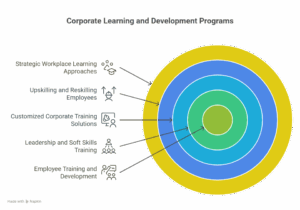In today’s fast-paced and fiercely competitive business environment, organizations must continuously evolve to stay relevant and thrive. This evolution hinges largely on their ability to adapt, innovate, and grow. At the heart of this transformation lies a critical driver—Corporate Learning and Development Programs.
Whether it’s staying ahead of emerging technologies, cultivating leadership capabilities, or fostering a culture of collaboration, investing in employee learning is no longer optional; it is a strategic imperative.
Corporate learning and development programs are essential for equipping employees with the skills and knowledge necessary to adapt to technological advancements, foster innovation, and drive organizational growth.
Corporate Learning and Development programs serve as the backbone for building a resilient and future-ready workforce. By continuously nurturing talent and promoting skill enhancement, these programs empower employees to meet evolving business demands and contribute meaningfully to organizational goals. When strategically designed and aligned with company objectives, Corporate Learning and Development programs not only boost productivity but also enhance employee engagement, retention, and overall job satisfaction.
This blog delves into the vital role of corporate learning and development programs, the myriad benefits it offers, and how companies can successfully implement effective training initiatives aligned with their unique business objectives.
Understanding Corporate Learning and Development Programs
Corporate Learning and Development Programs (L&D) are carefully designed training initiatives aimed at enhancing employee skills, knowledge, and overall competencies. These programs serve all organizational levels—from entry-level employees to senior leadership—with the ultimate goal of boosting individual performance and driving organizational efficiency.
Corporate Learning and Development Programs programs include:
- Employee Training and Development
- Leadership and Soft Skills Training
- Customized Corporate Training Solutions
- Upskilling and Reskilling Employees
- Strategic Workplace Learning Approaches
Corporate Learning and Development Programs initiatives can be delivered via a variety of formats, such as live virtual sessions, on-demand modules, intensive bootcamps, interactive workshops, and blended learning models. The objective is always to create a tailored learning journey that fosters tangible skill growth and measurable improvements in performance.
Successful Corporate Learning and Development programs are those that remain agile and responsive to the changing needs of both the workforce and the industry. By leveraging data-driven insights and regularly assessing learning outcomes, organizations can fine-tune their programs to ensure relevance and effectiveness. Furthermore, embedding a culture that values continuous learning encourages employees to take ownership of their development, making Corporate Learning and Development programs an integral part of everyday work life rather than a one-time event.

Why Learning and Development Matters
Employee Training and Development
Today’s workforce expects more than just a paycheck; they seek opportunities for personal and professional growth. Offering comprehensive employee training and development pathways results in:
- Enhanced employee engagement
- Increased job satisfaction
- Lower turnover rates
- Stronger alignment with organizational goals
Equipped with up-to-date knowledge and skills, employees become more confident, productive, and ready to tackle new challenges that support business success.
Customized Corporate Training Solutions
No two organizations are alike. Customized corporate training solutions ensure that learning programs are precisely aligned with a company’s goals, industry standards, and specific job roles. This tailored approach increases program relevance, maximizes learning outcomes, and guarantees a strong return on investment.
The Shift Toward Upskilling and Reskilling Employees
With rapid technological advancements and evolving job roles, upskilling and reskilling have become critical strategies for sustainable growth. The World Economic Forum predicts that by 2025, 50% of all employees will require reskilling.
- Upskilling focuses on refining and enhancing current skills to improve performance in existing roles.
- Reskilling involves training employees in new competencies, enabling career shifts in response to changing business needs.
The benefits of these strategies include:
- Ensuring business continuity
- Enhancing internal mobility and talent retention
- Lowering recruitment costs
- Building an agile, future-ready workforce
Companies like UpSkill365 offer scalable, flexible training models designed to equip teams with the skills necessary to stay competitive in this ever-changing landscape.
The Crucial Role of Leadership and Soft Skills Training
In the modern workplace, technical expertise is undoubtedly important—but it’s leadership and soft skills that truly set high-performing teams apart. As organizations grow, the ability to work collaboratively, communicate effectively, and solve problems strategically becomes just as important as any technical skill.
Leadership skills are no longer reserved for top executives; today, every employee needs to develop these traits to ensure they can lead by example, influence others positively, and drive company success. At the same time, soft skills such as emotional intelligence, empathy, and adaptability are essential in fostering a resilient, agile, and engaged workforce.
The value of soft skills training cannot be overstated. These skills empower employees to navigate complex situations, build stronger interpersonal relationships, and make decisions that benefit the entire organization. They not only improve individual performance but also cultivate a collaborative culture, where employees work more effectively together toward common goals.
Key areas of soft skills training that are indispensable for the modern workforce include:
Conflict Resolution: Navigating Difficult Conversations
Every organization faces disagreements and conflicts, whether they’re among team members, departments, or with customers. The ability to resolve these issues effectively and diplomatically is critical for maintaining harmony and ensuring that problems don’t escalate. Training in conflict resolution helps employees develop techniques to handle tension calmly, listen to all parties involved, and find solutions that benefit everyone.
Why it matters: High levels of unresolved conflict can lead to decreased productivity, disengaged employees, and a toxic workplace environment. Learning how to address conflicts proactively fosters trust and mutual respect.
Presentation and Public Speaking: Communicating Ideas with Confidence
Effective communication is one of the most essential soft skills for any professional. Whether presenting an idea in a meeting, pitching to a client, or delivering a keynote address, the ability to express oneself clearly and persuasively can make or break a professional reputation. Public speaking and presentation training teach employees how to structure their thoughts, speak confidently, and engage their audience, making their messages resonate.
Why it matters: Strong presentation skills increase an individual’s influence and credibility. It helps them connect with others, sell ideas more effectively, and inspire teams to act.
Time Management and Productivity: Maximizing Efficiency
In a world filled with distractions, time management has become an essential skill for employees at every level. Effective time management training helps employees prioritize tasks, avoid procrastination, and set realistic deadlines. Additionally, productivity tools and techniques, such as the Pomodoro Technique or Eisenhower Matrix, empower employees to maximize their focus and output.
Why it matters: Employees who manage their time effectively are less stressed, more productive, and better able to meet deadlines, which directly impacts team performance and overall organizational efficiency.
Team Collaboration and Interpersonal Communication: Strengthening Relationships
The success of any organization hinges on the ability of its teams to collaborate effectively. Team collaboration training focuses on improving communication, trust-building, and cooperation. Employees learn how to leverage diverse perspectives, resolve misunderstandings, and contribute to group problem-solving. By strengthening interpersonal communication, employees can build more meaningful relationships with colleagues, creating a sense of unity and shared purpose.
Why it matters: A collaborative environment enhances creativity, innovation, and collective problem-solving, leading to higher-quality work and greater job satisfaction for all team members.
Strategic Decision-Making: Thinking Ahead
In today’s fast-paced business world, the ability to make sound, data-driven decisions is crucial for long-term success. Strategic decision-making involves analyzing information, weighing risks, and considering various outcomes before making a choice. Employees with strong decision-making skills can make more informed and confident choices that align with organizational goals.
Why it matters: Leaders and employees who think strategically can navigate uncertain situations, identify opportunities for growth, and guide the company toward sustainable success.
Cultivating a Healthier, More Productive Workplace
Investing in leadership and soft skills training not only benefits individual employees but also enhances the broader company culture. When employees are trained to manage conflicts, communicate effectively, collaborate across teams, and make strategic decisions, the entire organization becomes more resilient, adaptable, and productive.
Furthermore, developing these essential skills results in:
- A Positive Work Culture: Training employees in leadership and soft skills fosters a culture of respect, trust, and open communication. Employees feel empowered to express their opinions, contribute to decision-making, and work collaboratively without fear of conflict.
- Better Customer Interactions: Employees with strong communication and emotional intelligence are more capable of understanding customer needs, resolving complaints, and providing excellent service.
- Stronger Cross-Department Collaboration: With improved interpersonal skills and teamwork abilities, employees can more easily collaborate across departments, resulting in more effective coordination and shared goals.
Building Effective Workplace Learning Strategies
To create impactful learning experiences, organizations should follow a deliberate, structured approach:
- Assess Learning Needs
Conduct thorough assessments through surveys, performance reviews, and role-specific analyses to identify knowledge gaps.
- Design Aligned Programs
Develop training content closely aligned with organizational objectives and employees’ developmental goals.
- Deliver Engaging Experiences
Use diverse learning formats—virtual, in-person, blended—to cater to different learning preferences and maximize engagement.
- Reinforce and Evaluate
Incorporate post-training support such as assignments, simulations, and feedback loops to ensure knowledge retention and measure training
effectiveness.

Best Practices for Corporate Learning and Development programs
Creating a high-impact Corporate Learning and Development programs (L&D) strategy is an ongoing process that requires thoughtful planning and continuous improvement. By following best practices, organizations can ensure that their training programs lead to meaningful growth, higher employee engagement, and measurable business outcomes.
To maximize the effectiveness of Corporate Learning and Development programs, organizations should prioritize a learner-centric approach that tailors content to individual needs and career paths. This involves leveraging data and feedback to continuously refine training materials and delivery methods. Additionally, integrating technology—such as e-learning platforms, mobile apps, and virtual classrooms—can enhance accessibility and engagement. Strong leadership support and clear communication of the program’s value are also crucial to foster a culture of continuous learning. By embedding these best practices, Corporate Learning and Development programs become powerful tools for driving both personal growth and organizational success.
Here’s how companies can elevate their corporate Learning and Development programs initiatives:
Set Clear, Measurable Learning Objectives
Every successful orporate Learning and Development programs begins with a clear understanding of its goals. Defining success criteria before launching a program ensures that efforts are focused and aligned with business needs. Whether you’re training employees in technical skills, leadership, or soft skills, your objectives should be specific, measurable, and achievable.
Best Practice: Use frameworks like SMART (Specific, Measurable, Achievable, Relevant, Time-bound) goals to define precise learning outcomes and track progress over time.
Leverage Data-Driven Insights to Optimize Training
Data is a goldmine for improving the effectiveness of your learning programs. By regularly analyzing key performance indicators such as course completion rates, learner assessments, and post-training performance metrics, companies can identify areas of improvement and tailor future learning content to better meet employee needs.
Best Practice: Use tools like learning management systems (LMS) or integrated HR analytics platforms to track and measure training effectiveness. Metrics such as engagement rates, learning retention, and post-training performance can provide actionable insights.
Foster a Culture of Continuous Learning
A successful L&D program isn’t just about structured training sessions—it’s about embedding learning into the very fabric of the organization. Leaders should promote the value of continuous learning as part of the company’s culture. By doing so, employees are more likely to engage with learning opportunities, both formal and informal, and view their development as a lifelong journey.
Best Practice: Create an environment that supports self-directed learning. Encourage employees to engage in webinars, e-learning, podcasts, or even informal lunch-and-learns to keep learning consistent, accessible, and integrated into their daily work routine.
Enhance Accessibility to Maximize Participation
One of the most significant barriers to effective learning is accessibility. If your L&D program only works for those who are physically present or available during specific hours, it will leave many employees behind. To ensure maximum engagement, it’s essential to offer mobile-friendly, on-demand, and self-paced learning options that cater to diverse work schedules and geographical locations.
Best Practice: Implement an adaptive learning platform that offers microlearning modules, mobile access, and on-demand resources. These tools allow employees to learn at their own convenience, breaking down complex topics into smaller, digestible lessons.
Provide Ongoing Support to Ensure Skill Mastery
Learning doesn’t end once the course is completed. To achieve real, lasting change, employees need ongoing support and reinforcement. Coaching, mentoring, and opportunities for applying learned skills in real-world scenarios are crucial for reinforcing and deepening knowledge. Post-training activities help learners bridge the gap between theory and practice, ensuring that skills are applied effectively on the job.
Why it matters: Without follow-up and continued practice, the learning curve may plateau quickly. Ongoing support not only boosts retention but also allows employees to continuously refine and apply their newly acquired skills, ensuring they add long-term value to the organization.
Best Practice: Create post-training mentorship programs or peer-to-peer networks to foster continuous knowledge-sharing. Encouraging employees to apply their skills in live projects and providing regular check-ins with managers or mentors can significantly enhance learning retention and application.

Measuring the ROI of Learning and Development Programs
Assessing the return on investment (ROI) for learning and development initiatives is critical for organizations seeking to validate the impact of their training efforts and make informed decisions about future investments. A robust evaluation of ROI not only demonstrates the tangible value of these programs but also highlights areas for continuous improvement.
Organizations can effectively measure the ROI of L&D programs by monitoring key performance indicators such as:
- Increased Employee Productivity: Tracking improvements in output, efficiency, and quality of work following training.
- Revenue Growth Attributable to Enhanced Skills: Linking skill development to sales performance, customer satisfaction, and overall business growth.
- Decreased Errors and Operational Downtime: Measuring improvements in accuracy and fewer disruptions, which lead to smoother business processes.
- Enhanced Employee Retention and Job Satisfaction: Monitoring turnover rates and engagement scores to understand how learning initiatives contribute to a more committed workforce.
By partnering with seasoned corporate training providers like UpSkill365, organizations gain access to expertly crafted learning programs that are strategically aligned with business goals. This ensures that every training investment delivers measurable, meaningful outcomes that drive long-term success and a competitive edge.
Real-World Examples of Impactful Learning Programs
IT Company: Upskilling in Cloud and Cybersecurity
A mid-sized IT firm collaborated with UpSkill365 to upskill 200+ employees in AWS cloud and cybersecurity fundamentals. Within months, project delivery speed improved by 30%, and reliance on costly third-party consultants decreased significantly.
Healthcare Provider: Soft Skills for Nursing Staff
A leading hospital implemented UpSkill365’s soft skills training focused on communication and teamwork for nursing staff. The result was improved patient satisfaction scores and smoother internal operations.
Manufacturing Firm: Leadership Development for New Managers
First-time managers in a manufacturing company received coaching and mentoring through UpSkill365’s leadership programs. Within six months, the organization observed notable improvements in team performance and cross-department collaboration.
FAQs
- What makes UpSkill365 Corporate Learning and Development Programs unique?
UpSkill365 combines over 15 years of expertise with a highly customized approach, crafting training solutions tailored to your organization’s specific goals and workforce needs. Their focus on measurable outcomes ensures skill mastery and a clear return on investment.
- How does UpSkill365 support upskilling and reskilling for evolving business needs?
UpSkill365 offers flexible learning pathways that include both technical and soft skills programs, helping employees stay current with industry trends and enabling smooth transitions to new roles when required.
- Can UpSkill365 deliver training in both virtual and in-person formats?
Yes! UpSkill365 provides live virtual classes, on-demand self-paced courses, workshops, and blended learning options designed to fit your company’s culture and scheduling needs.
- What post-training support does UpSkill365 provide?
Post-training, UpSkill365 reinforces learning through simulations, assignments, coaching sessions, and continuous feedback to ensure skills are applied effectively in the workplace.
- How does UpSkill365 measure the effectiveness and ROI of its training programs?
UpSkill365 employs a comprehensive evaluation framework that tracks performance metrics and business outcomes, ensuring that training initiatives deliver tangible, strategic benefits.
Conclusion: The Future Belongs to Learning Organizations
In an era defined by constant change and disruption, organizations that prioritize continuous learning will be the ones that thrive. Corporate Learning and Development Programs are no longer just tools—they are strategic levers that drive innovation, growth, and resilience.
Effective Corporate Learning and Development Programs provide the essential framework for closing skills gaps and empowering employees to meet evolving business demands. By integrating these programs deeply into their culture, organizations foster agility and prepare their workforce for future challenges.
Investing in Corporate Learning and Development Programs, along with customized training solutions and a focus on leadership and soft skills, enables businesses to build adaptable, collaborative teams. This commitment to continuous learning is key to long-term success.
The path forward is clear: nurture a culture of continuous learning with robust Corporate Learning and Development Programs, and your organization will be well-positioned to navigate whatever the future holds.

